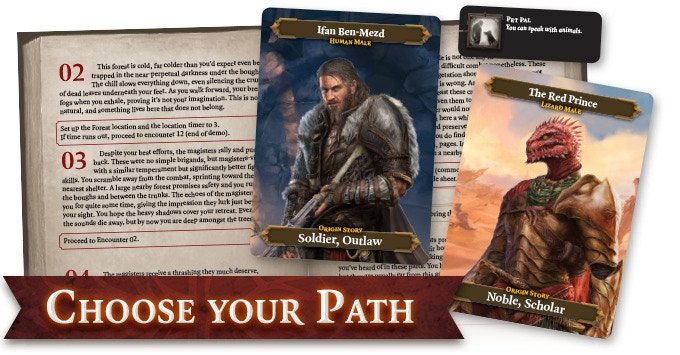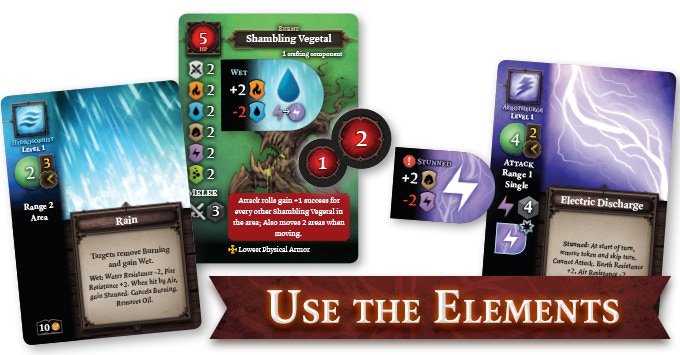We take a look at the Kickstarter for Larian Studios and Lynnvanders's Divinity Original Sin: The Board Game to see how well it matches the video games that spawned it.
It took more than 80 hours for me to beat Divinity: Original Sin. Developer Larian Studios only needed four to crowdfund the creation of Divinity Original Sin: The Board Game. It’s fair to say that the analog adaption of their tactical RPG series has drawn quite a bit of interest since it launched on Kickstarter, rocketing past its initial funding goal of $160K to, at the time of writing, just surpass the heady heights of $1 million.
Divinity: Original Sin and its superb sequel built up quite the fanbase in recent years, and Larian Studios is keen to capitalize on that. Teaming up with Lynnvander, they’ve produced a board game adaption that aims to stay true to its weird and wonderful inspiration. So how well does Divinity Original Sin: The Board Game match up to its virtual counterpart? Let’s take a look at what we know so far.
Characters, agency and story

© Larian Studios
From the off, it’s clear that this adaption is targeted directly, perhaps exclusively, toward fans of the video game. Familiar faces and talk of magisters make it clear that the story is based on that of Divinity: Original Sin 2, but this isn’t a simple case of retreading ground. The choice of playable characters includes returning favorites such as The Red Prince and Ifan Ben-Mezd, while new origin stories offer temptingly different perspectives from which to explore the world.
Narrative agency is core to the Original Sin experience, and that means having the chance to effect real change in the world around you, as well as seeing it react to your identity. Characters in the Original Sin video games aren’t blank slates. They come with innate traits that open up or sometimes even restrict dialogue choices; being a noble might let you converse with air of command, while being a scholar allows an understanding of arcane runes.
The same is true in the board game. Each persona comes with a couple of core characteristics, and you’ll have the option to pick additional traits at specific levels as well (and yes, you can pick Pet Pal to talk with animals). As you read the story, you’ll see these traits crop up in the text, letting you rifle through the book to find a unique avenue for progression. It’s a system designed to encourage replayability, leaving you wondering what might have happened had you followed another path.
Lynnvander has been unashamed in describing Divinity Original Sin: The Board Game as a choose-your-own-adventure story, with far-reaching consequences tied to your decisions. As you set up for and explore encounters, you’ll regularly need to hop back and forth between pages of the manual to discover if a decision taken earlier has come back to reward or bite you. Yeah, maybe laughing at that chained up dragon wasn’t such a good idea, even if it did seem funny at the time.
If this all sounds like a bit too much reading for you then, well, welcome to Divinity. You did play Original Sin, didn’t you? There’s an awful lot of text here to digest, but without having had a chance to go hands-on with the game, we’ll just have to hope that the writing can measure up to the wit and humor found in Divinity: Original Sin 2. Sorry developers, but if players aren’t writing fanfictions about their favorite undead companion after beating this board game, then you’ve let us all down.
One key difference comes in the form of experience. This being an RPG, you’ll have the chance to level up as you complete quests and overcome foes. In an effort to do away with tracking fiddly experience point numbers that video games handle automatically, however, you’ll instead earn levels at key points in the story, with the entire party awarded at once through sections of text. It’s a step away from the video game, but one that feels sensible.
Action points, skills and combat

© Larian Studios
For those of us who’ve committed countless hours to the digital editions, combat in Divinity Original Sin: The Board Game is instantly recognizable. The video games employ turn-based battles, giving characters a number of action points to spend on movement, items, attacks, skills, or spells each turn. Doing away with mana and other meters, it’s a simple system that translates well to board gaming, so it’s no surprise to see action points included here, too.
Journeying through the world, players will acquire skills and spells taken directly from the video game. Each comes with an action point cost and a cooldown timer, with activated cards shifting across the top of your playerboard before returning to your hand after several turns. Mechanically, it’s extremely similar to the video games. So much so in fact, that experienced Divinity players will likely already have builds and strategies in mind for each character before they start.
The key to the video game’s genius, however, is in mixing the environment with a range of physical and elemental statuses. Letting players come up with creative solutions to that all-too-common RPG problem of a skeleton trying to stab your face off is core to the Divinity experience, and it’s here that the board game is forced to differ somewhat. Teleporting enemies into carefully placed oil spills and explosive barrels is simple in a 3D space but far more tricky to represent with 2D cards.
Combat in the board game takes place across a set of locations, each at a certain range from one another and containing modifiers to damage or magic dealt from them. It’s immediately less open to the precise tactical positioning and systemic, physics-based entertainment that the video games are known for. That said, Larian and Lynnvander have made sure there’s still plenty of opportunity for entertaining mishaps.
Friendly fire is always on the table, and with 16 modifying status tokens to apply, you’ll need to keep a careful eye on where you’re flinging those fireballs. This also allows for a level of creativity in your attacks; targeting a burning friend with a water-based strike is an effective way to douse their flames. Provided, of course, that you don’t accidentally deal more damage than the fire would have in the first place.
Sticking with the source

© Larian Studios
All in all, it seems like Larian and Lynnvander have gone to great lengths with Divinity Original Sin: The Board Game to replicate the feel of the video game series. It’s an impressive feat and a testament to their respect for the conversion’s origins. From here the real question becomes whether or not sticking so firmly to the source mechanics makes for a good board game.
There are a lot of little details to keep track of, from status and location modifiers to cooldown timers, traits, and more. Divinity Original Sin: The Board Game may prove a confusing prospect for those stepping in uninitiated, but anyone who’s romped through the digital world of Rivellon will likely feel as though they’re returning to a very familiar home. One housing an arrogant red lizard prince who can turn friends and foes alike into chickens on a whim but a home nonetheless.
Look, we never said it wouldn’t be weird.
After more board gaming goodness? Be sure to follow Going Analog on Twitter, Facebook, and Instagram as well.


